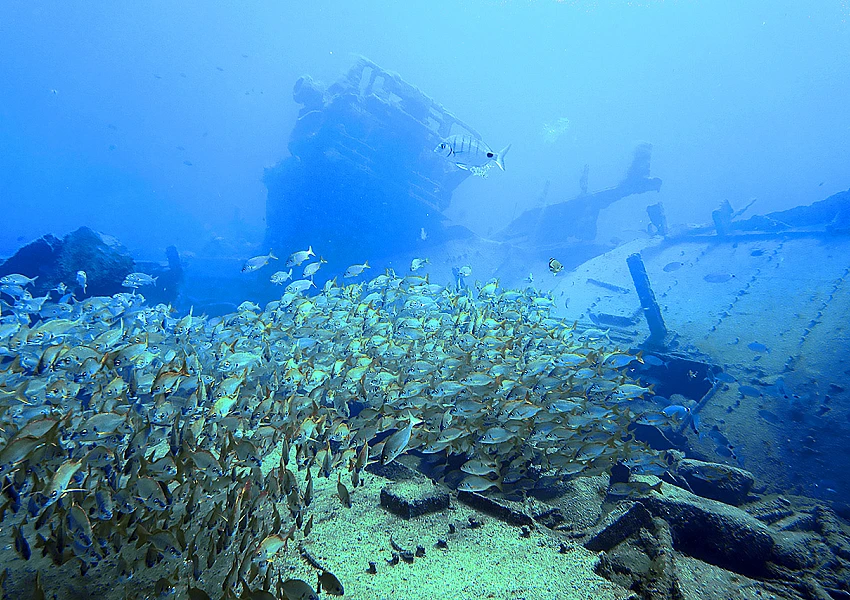Dive details
Table of Contents
The Blue Bird dive site, located off the southwestern coast of Gran Canaria near the charming town of Arguineguín, is named after the shipwreck of a small passenger ferry that once sailed these waters. The vessel, which met its watery fate in the mid-20th century, now rests peacefully at a depth of approximately 38 meters (125 feet). Over the years, the wreck has transformed into an artificial reef, attracting a plethora of marine life and becoming a haven for underwater photographers, wreck enthusiasts, and advanced divers alike.
The Blue Bird is more than just a wreck; it’s a living, breathing ecosystem that showcases the resilience of nature. The ship’s structure, now encrusted with colorful corals, sponges, and anemones, provides shelter and sustenance to a diverse array of marine species. As you explore the wreck, you’ll be stepping back in time, experiencing the unique blend of history and nature that makes this site truly special.
The Blue Bird Dive Experience: What to Expect Underwater
Diving at Blue Bird is an adventure that begins as soon as you make your descent. The waters around Gran Canaria are known for their clarity, and as you descend towards the wreck, the outline of the ship gradually comes into view, shrouded in the blue hues of the deep sea. This moment is nothing short of magical, as the ghostly silhouette of the Blue Bird emerges from the depths, inviting you to explore its secrets.
The wreck is relatively intact, with several parts of the ship still recognizable, including the bow, stern, and sections of the hull.
One of the most compelling aspects of the Blue Bird dive is the abundance of marine life that inhabits the wreck and surrounding area. The site is teeming with a variety of species, making every dive a unique experience. Expect to encounter schools of barracuda, which often patrol the waters around the wreck, their silvery bodies glinting in the sunlight. Groupers, some of them quite large, can be seen lurking around the structure, while moray eels peer out from crevices, their mouths opening and closing in a menacing yet mesmerizing display.
In addition to these larger species, the Blue Bird wreck is home to a host of smaller creatures that add to the site’s biodiversity. Keep an eye out for nudibranchs - colorful sea slugs that are a favorite among macro photographers - as well as shrimp, crabs, and the occasional octopus hiding within the wreck. If you’re lucky, you might even spot a stingray gliding gracefully over the sandy bottom, adding to the site’s allure.
Planning Your Dive: Tips and Recommendations
Given the depth of the Blue Bird wreck, this dive site is best suited for advanced divers. It’s highly recommended that you hold at least an Advanced Open Water certification with Deep Diver specialty or equivalent, as well as experience in deep diving. Proper preparation is key to ensuring a safe and enjoyable dive.
Here are some tips to help you make the most of your Blue Bird diving experience:
1. Use a Dive Computer: Due to the depth and potential for nitrogen accumulation, a dive computer is essential for monitoring your time and depth, helping you stay within safe limits.
2. Check the Conditions: Before heading out, check the sea conditions and currents, as they can vary and affect the difficulty of the dive. Local dive centers can provide up-to-date information and recommendations.
3. Plan Your Dive, Dive Your Plan: As with any dive, proper planning is crucial. Discuss your dive plan with your buddy and guide, ensuring that everyone is aware of the depth, time limits, and any specific points of interest.
4. Bring a Torch: Although the visibility is generally good, bringing a torch can help you explore the darker areas of the wreck and highlight the vivid colors of the marine life.
Dive Profile
- Depth: The Blue Bird wreck lies at a depth of approximately 30 to 38 meters (98 to 125 feet). The depth at the site can vary depending on where you dive around the wreck, with the shallowest parts at about 30 meters and the deepest parts reaching close to 38 meters.
- Bottom Time: The suggested bottom time will vary based on your dive plan, air consumption, and dive computer readings. Given the depth, bottom time is typically limited to 15-20 minutes to avoid excessive nitrogen absorption and to allow for a safe ascent, including any required decompression stops. Always use a dive computer to monitor your no-decompression limits (NDL).
- Water Temperature: The water temperature in Gran Canaria typically ranges from 18°C (64°F) in winter to around 24°C (75°F) in summer. A 5mm to 7mm wetsuit is usually recommended, with the thicker end of the range being preferable in winter months.
- Visibility: Visibility at the Blue Bird site can range from 20 to 30 meters (65 to 100 feet), depending on sea conditions, time of year, and weather.
Suggested Dive Plan
- Descent: Begin your descent along the anchor line or down the mooring line provided by your dive boat to control your rate of descent and conserve air. This approach also helps you navigate directly to the wreck.
- Exploration: Start your exploration of the wreck at its shallowest point, which is around 30 meters, and gradually make your way to the deeper sections. This allows you to manage your nitrogen absorption efficiently.
- Photography and Observation: Use your time at the wreck to observe the marine life and take photos, being mindful of your remaining bottom time. Avoid penetrating the wreck unless you have the proper training and certification.
- Ascent: Begin your ascent with plenty of air reserve, and ensure to do a deep stop (if using a dive computer) and a standard 3-minute safety stop at 5 meters (15 feet) to off-gas excess nitrogen.
Marine Life and Underwater Landscape
- Marine Life: The Blue Bird wreck is home to a variety of marine species, including:
- Barracuda: Often found schooling around the wreck.
- Groupers: Large groupers are frequently seen patrolling the area.
- Moray Eels: Found in the crevices of the wreck.
- Nudibranchs: Colorful sea slugs are a common sight for macro enthusiasts.
- Stingrays: Occasionally spotted on the sandy bottom near the wreck.
- Octopus: Sometimes hiding within the wreckage.
Diver Experience Level
Experience Level: The Blue Bird site is classified as an advanced dive due to its depth and the potential for strong currents. It is highly recommended for divers with at least an Advanced Open Water and Deep Diver Specialty certification and experience in deep diving.
Safety Considerations
- Currents: There can be moderate to strong currents. Plan your dive accordingly and be prepared to adjust your dive plan based on conditions.
- Decompression: Given the depth, it’s important to be vigilant about your no-decompression limit (NDL). Always dive with a computer and monitor your nitrogen levels closely.
- Equipment: A dive computer is essential for managing depth and time. Bringing a torch is also recommended for better visibility inside the wreck and to see the true colors of the marine life.
Why Blue Bird Should Be on Every Diver’s Bucket List
The Blue Bird dive site in Gran Canaria offers a unique and thrilling experience for those seeking to explore a wreck that has become a thriving underwater ecosystem. With its rich history, diverse marine life, and the eerie beauty of the sunken ferry, Blue Bird is more than just a dive site—it’s a journey into the past and a celebration of the resilience of nature.
Whether you’re an advanced diver looking for a new challenge, a wreck enthusiast eager to explore a well-preserved site, or an underwater photographer seeking the perfect shot, Blue Bird has something to offer. Its location in the beautiful waters of Gran Canaria makes it easily accessible, and the island’s warm climate ensures that you can dive here year-round.
As you plan your next diving adventure, make sure to include Blue Bird on your itinerary. This hidden gem of Gran Canaria promises an unforgettable experience that will leave you with memories to cherish and stories to tell. So, gear up, take the plunge, and discover the underwater wonders that await at the Blue Bird dive site - one of the Canary Islands’ most captivating and beloved dive destinations.










